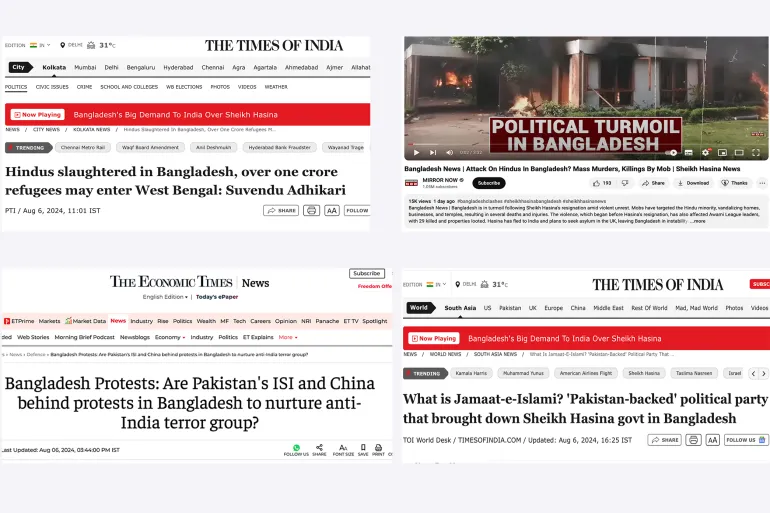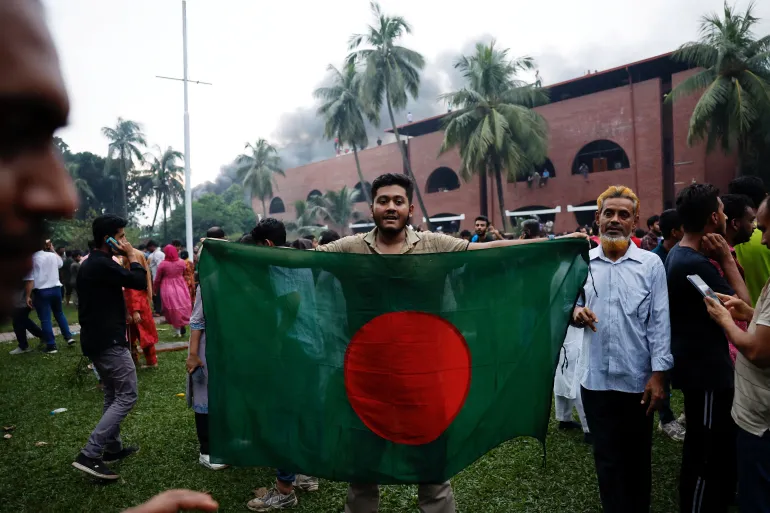After the political upheaval in Bangladesh, where Sheikh Hasina was removed from power following a student-led public uprising, some Indian media outlets began reporting that members of the Hindu minority in Bangladesh were being targeted by “Islamist forces.” These reports, however, have been questioned for their accuracy and reliability.
Misinformation, including articles and videos, appeared on Indian media and social media platforms. According to an investigative report by Al Jazeera, a video on the YouTube channel ‘Mirror Now,’ owned by the Times Group, was titled “Attacks on Hindus in Bangladesh? Mass killings, lynching.” The video showed footage of violent attacks and arson on four houses, two of which were later identified as being owned by Muslims. The title of the video was misleading as there were no reports of mass killings in the incident. Local reports indicated that one of the houses belonged to Bangladesh’s independence leader Sheikh Mujibur Rahman.
The video also made unverified claims, such as “24 burned alive by a mob” and “Minorities targeted in attacks.” Al Jazeera independently verified that since Hasina Wajid’s ouster, only two Hindus had been killed—a police officer and a member of Hasina’s Awami League.
Hindus make up about 8% of Bangladesh’s population of 170 million and have traditionally been strong supporters of the Awami League, which is generally seen as more secular compared to the opposition alliance, which includes an Islamist party.
Reports of attacks on Hindus contained bizarre claims, such as “Over one crore refugees likely to enter West Bengal soon,” a claim made in a Times of India report quoting a senior leader of the ruling party, Suvendu Adhikari.
The ANI news agency, which supports the Modi government, quoted a student leader in India claiming that the widespread uprising was “organized by Bangladesh’s enemies.” Another strange article in the Times of India claimed that Bangladesh’s largest Islamist party, Jamaat-e-Islami, had “toppled Sheikh Hasina’s government.”

Political analyst Zahid Rahman stated that the Indian media reported on Bangladesh through an “Islamophobic” lens. He told Al Jazeera that the student movement that fueled the public uprising included people from all walks of life and is a popular movement in Bangladesh, but somehow, Indian media is interpreting the entire scenario through its Islamophobic perspective.
After Hasina Wajid fled the country, Indian media accused Pakistan’s intelligence agency, ISI, of being behind the protests in Bangladesh, allegedly trying to turn Bangladesh into an Islamic state with political support.
Bangladesh, Situation Normalizing, Interim Government to Take Oath Today
Some Indian media even urged the Indian government to prepare for a potential refugee crisis, speculating that Hindus would be expelled from Bangladesh.
In some social media posts by commentators and Indian media outlets, there was a strong effort to link ISI and China to the political situation in Bangladesh.
In an interview with Al Jazeera, Gobindra Chandra Pramanik, a leader of the Hindu community in Bangladesh, said that to his knowledge, no Hindu households, unrelated to the Awami League, had been attacked. He confirmed that the attacks were politically motivated, not communal. Across the country, Muslim households associated with the Awami League faced ten times more attacks.
Zafar Sobhan, editor of Bangladesh’s Dhaka Tribune newspaper, told Al Jazeera that most Indian media is “uninformed about Bangladesh.”
Political analyst Farid Arquiza Bakht said that the disinformation spread by Indian media reflects New Delhi’s intent to destabilize Dhaka. He added that India has lost its most valuable ally in the subcontinent and is deeply concerned about the direction of the incoming administration.

